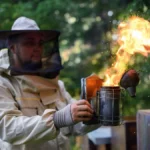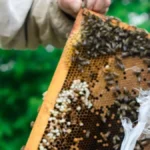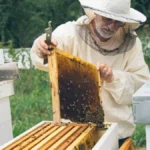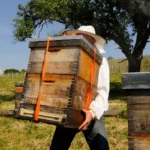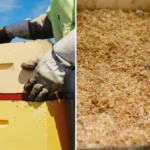Beekeepers need to use bee smokers when they want to inspect the bee hives or collect honey. Smoke calms the bees and prevents them from attacking or triggering a defensive response by masking their danger pheromones. This means you won’t make them mad, and are less likely to get stung. Really, it’s a win-win for both the beekeeper and the hive, so make sure you have a good smoker ready!
In this guide, we will cover the best practices and safety precautions regarding the use of a beekeeping smoker.
Why Use Beekeeping Smoker To Control Bees
Smoking beehives is an ancient practice and may be as old as honey harvesting.
Smoke consists of airborne particles derived from combustion of certain materials. When bees encounter the smoke, they quickly fill up on honey thinking that they have to leave the hive due to the fire. These engorged honeybees become passive, cannot fly fast, and are much less likely to sting or show aggression than hungry honeybees.
In addition, every beehive has a few guard bees that release alarm pheromones when the hive is opened or disturbed. These alarm pheromones smell like ‘banana oil’. When other bees sense this pheromone, they tend to get defensive and aggressive. The smoke from a beekeeping smoker masks this initial release of pheromones from the guard bees. Thus, it reduces the sensitivity of the pheromone receptors of the other bees. They then continue their routine hive duties rather than taking on a defensive stance.
Smoke also helps drive the bees away from or toward a particular area of the hive. Moreover, if you have already encountered an angry bee who managed to sting you, the smoke masks the same alarm pheromone left behind even after you have been stung. The base of the sting remains on your skin and tags the area for the other bees to attack so you need to get rid of it. This is why you must also smoke your suit, hat, and gloves and launder these items regularly to remove the pheromones.

Buying Your Beekeeping Smoker and Fuel
Beginner Beekeepers should consider the purchase a larger beekeeping smoker even if you have a smaller hive or just beginning beekeeping. Larger smokers are easier to light, burn longer, and less likely to fail when you need them the most. These days, you can also buy an electric bee smoker which is a lot safer than traditional ones.
Bee Smoker Fuel
Eva Crane, author of the book The World History of Beekeeping and Honey Hunting, recommends using fuels that will produce cool smoke with little ash deposit. This is safe for the bees.
Some great choices in bee smoker fuel include:
- Dried dung- cow or horse dung burns well without odor
- Pine needles
- Dried herbs
- Straw or dried grass mixed with wood chips or bark
- Dry rotted punk wood- this burns hot, so use it with other fuels.
- Woodshavings, sawdust mixture
- Sumac bobs
- Peanut shells
- Untreated, dry burlap
- Rags made of 100% cotton- something like muslin
- Dried citrus peels
- Corncobs
See the Price comparisons of Bee Smoker Fuel Type Costs
These materials keep the smoke cool and won’t harm the bees. You can also put a thin layer of green grass on top of the fuel of your choice to cool the smoke. This layer catches the ash and keeps your bees from getting burned.
Understand that every beekeeper has their favorite bee smoker fuel. Use the one that best suits you and is also readily available in your locality.
Avoid These Fuels
The following fuels give off a toxic smoke that can harm the bees:
- Synthetic materials
- Petroleum starters
- Rags treated with pesticides
- Newspapers (as the only fuel) – this produces too much ash and can burn the bees
- Binder twine from hay bales- this is treated with rot-retarding chemicals which can be toxic to the bees.

How To Use a Bee Smoker
Step 1
Practice lighting the smoker several times outside the apiary before actually using the bee smoker. This will help you get familiar with the device. There is nothing worse than having your best bee smoker go out when you are in the middle of examining a hive.
Pro Tip – Always carry extra matches when smoking the hive.
Step 2
Drop a small amount of blazing fuel (could be a piece of newspaper) to the bottom of the smoker. Puff the smoker bellows and add unburned material to the smoker. Puffing air will help ignite the fuel as you pack the device.
Step 3
If your fuel is a bit damp, add in a bit of beeswax and use a blow torch to start the fuel. Keep puffing so the smoker stays lit.
Step 4
If your smoker catches fire or gets too hot, you need to cool it down slightly. To do so, add a handful of green grass over your beekeeper smoker fuel. This will reduce the ash and protect your bees. But do take precautions so that you don’t put out the fire.
Also read: The Best Beekeeping Equipment and Tools for Beginner Beekeepers
Pro Tip – Do not pack the smoker too tightly. As you work, keep adding fuel. A large smoker should last for 45 minutes to an hour.
Step 5
- After firing up the smoker, snap the nozzle top closed before the flames can cascade out. Always aim it away from your face and body.
- Shoot a few puffs of smoke at the hive’s entrance before opening the hive top cover. Also, puff some smoke into the inner cover hole of the hive. You will see bees retreat down the hive.
- Use the smoker’s hanging hook to hang the smoker near the open hive. Avoid placing the smoker on the ground where it could start a bushfire. Hanging the smoker also keeps it handy when you need it.
- Always ensure that only smoke comes out of the smoker and not flames.
- Do not over-smoke. Smoking does not harm the bees as long as you do not use it excessively.
- As you gain experience, you should be able to use less smoke– just a few brief squeezes of bellows should be sufficient.
Precautions to Take After Use
- Open the smoker, add in your hive tools, puff a blaze, and sterilize your tools.
- Empty the remaining fuel onto dirt or pavement and drench them with water.
- Stuff some green grass or cork into the nozzle of the smoker to put out the smolders in case you do not have water on hand.
- Always make sure the smoker is completely cool and the fire is completely out before putting away the smoker.
- Sand the smoker clean to eliminate soot from inside the nozzle.
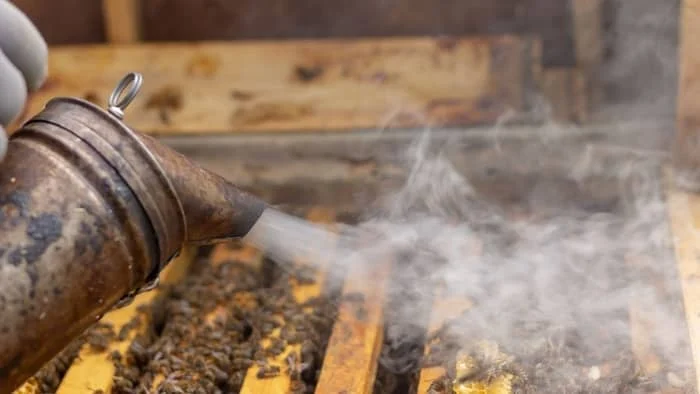
The Beekeeper Smoker
Every beekeeper may want to use the best bee smoker at some point when handling the hive. It is essential to learn how to use it correctly because every time you fire it up, you are starting a small fire. You can always go in for an electric bee smoker which is less likely a fire hazard.
We hope this guide helps you follow the best practices and precautions for using a beekeeping smoker safely.
Beekeeping Smoker FAQs
What Is the Purpose of a Beekeeping Smoker?
A beekeeping smoker calms bees by masking their alarm pheromones, making them less defensive and easier to manage during hive inspections or honey collection.
How Does Smoke Affect Bees?
Smoke causes bees to fill up on honey, making them less likely to sting. It also masks alarm pheromones, preventing other bees from becoming aggressive.
What Are the Best Fuels to Use in a Beekeeping Smoker?
Some excellent smoker fuels include pine needles, dried herbs, straw, cotton rags, dried dung, and untreated burlap. These produce cool smoke that is safe for bees.
What Fuels Should Be Avoided in a Beekeeping Smoker?
Avoid using synthetic materials, petroleum-based products, treated fabrics, or newspaper as the only fuel. These can produce toxic smoke harmful to bees.
How Do You Light a Beekeeping Smoker?
Start with a small amount of blazing fuel, puff the bellows to ignite, and gradually add more unburned material. Ensure the fuel is well-packed but not too tight to keep airflow.
How Do You Control the Smoke Temperature?
Add a layer of green grass or other damp material on top of the burning fuel to cool the smoke and reduce ash production.
How Should You Use a Smoker During Hive Inspections?
Direct a few puffs of smoke at the hive entrance and inner cover hole. This encourages bees to retreat and reduces their defensiveness during inspections.
How Long Should a Smoker Stay Lit?
With proper fuel and airflow, a large smoker can stay lit for 45 minutes to an hour. Always carry extra fuel and matches just in case.
What Precautions Should You Take After Using a Smoker?
Empty the fuel, drench it with water, and ensure the smoker is completely cool before storage. Clean soot buildup to maintain performance.
Can an Electric Smoker Be a Good Alternative?
Yes, electric smokers are safer and easier to use, especially for beginners, as they eliminate the risks associated with open flames.

Sam Fielding is an apiary student at The Ohio State University with a strong passion for beekeeping and honey production. Dedicated to advancing the resilience of bees, Sam is actively involved in establishing bee colonies in the lower regions of the United States, including Texas and Florida, as part of a volunteer program. His hands-on experience in these diverse climates has given him a unique perspective on bee health and hive management.
Sam’s dedication to both the scientific and ethical aspects of beekeeping makes him a valuable voice in the apiculture community, advocating for both bee health and consumer rights. He also helps us maintain our facebook page, so feel free to get in touch with him there!

